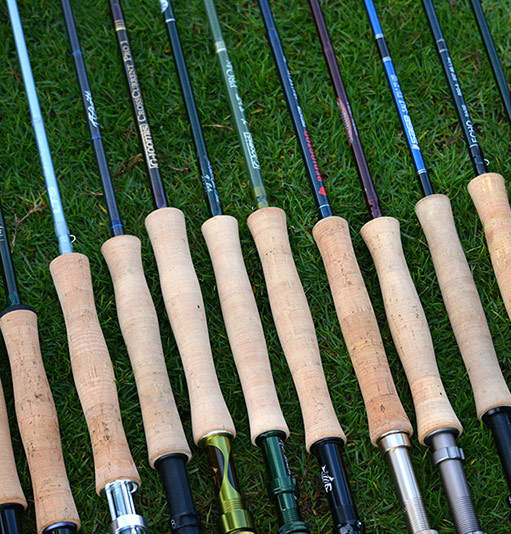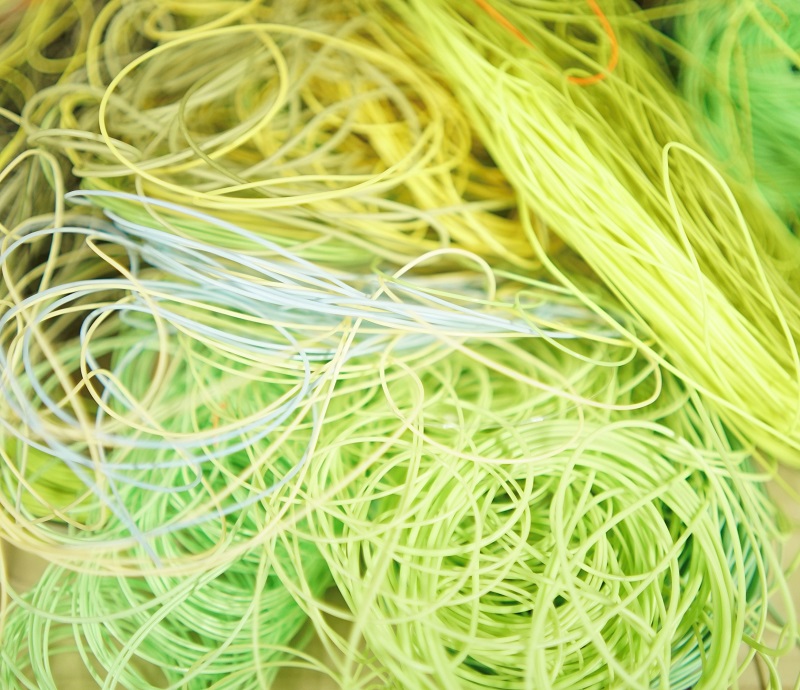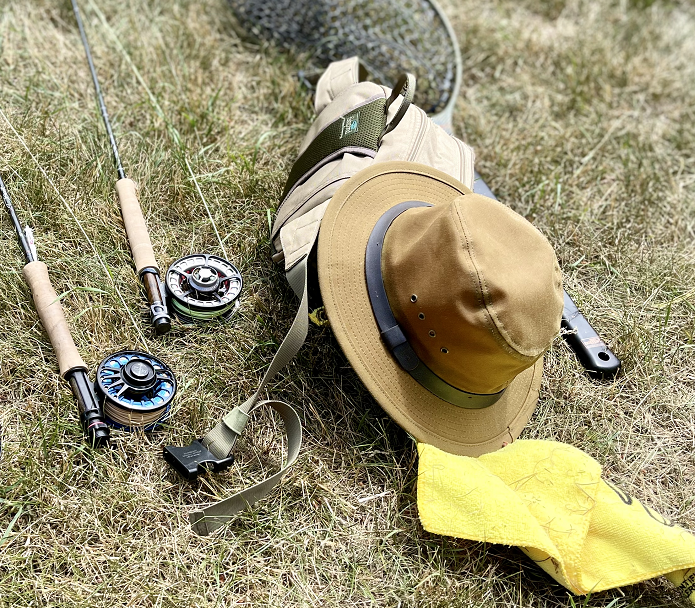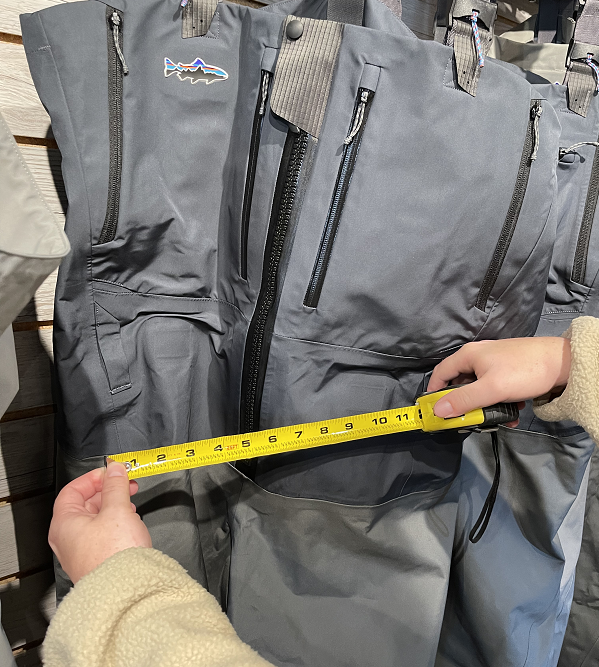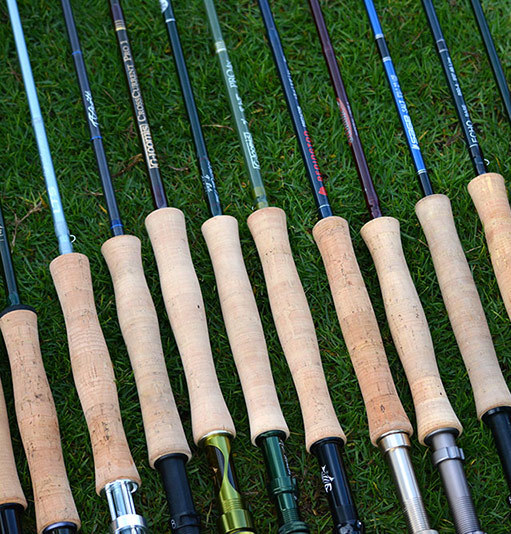
HOW TO CHOOSE A FLY ROD
Expert advice on how to choose a fly rod. Selecting the right fly rod can be an intimidating experience. There are seemingly endless options, mountains of information, and unlimited opinions by everyone and anyone. The more you read, the more confusing things can become, so before jumping too far into the details about fly rods, let's talk about the function of a fly rod. A fly rod, at the end of the day, has three purposes:
- Casting - Like a spin rod, the fly rod allows for the fly line to be cast with power and accuracy. A good fly rod and line, in combination with good fly casting skills, also allows the fly and fly line to be presented accurately, without spooking the fish.
- Line Control - Once the fly is floating on the water, the next function of a fly rod is to provide line control. A fly rod allows for control over the line that is out on the water - at least once the angler learns how to do it.
- Striking and Landing Fish - The fly rod is used to both set the hook on a fish and to fight and land the fish. As such, the fly rod needs to be flexible and strong enough to bend, sometimes under great pressure, without breaking or snapping.
In an effort to clarify some of the confusion that often accompanies the purchase of a fly rod, we’ve prepared this buyers guide. Hopefully this article will allow you to walk away with a better idea of what kind of fly rod to get, and why.
First Step - Determine What You Fish For
Now that we know what the purpose of the fly rod is, it is time to be honest and ask yourself a question - exactly what types of fish will I be fishing for? You must answer this question honestly since the answer to this question determines everything else that follows.
For example, you need a different type of fly rod to fish for trout than you do for largemouth bass or saltwater species. So give some thought to which fish species you will targeting most of the time.
Understanding Fly Rod Action
There are few things more confusing in the sport of fly fishing than fly rod action. So let's explain things - its actually quite simple.
The action of a fly rod refers to how flexible the fly rod is. If you forget everything else, try to remember this. The action of a fly rod is simply a fancy measure of how flexible the fly rod is.
With that in mind, essentially, there are three different types of fly rods that a beginning angler should concern themselves with. The three different types of fly rods are differentiated by the amount of flex in the fly rod. How is the amount of flex in a fly rod measured? Simple, it is measured on the backcast. The more the rod bends on the backcast, the more flexible the fly rod is.
The Three Types of Fly Rod Action
All fly rods will have one of three types of "action." Fly rod action, as explained above, is just a term that expresses how flexible a fly rod is. The three types of fly rod action are fast-action, medium-action and slow-action. Each of these types of action have their benefits and drawbacks. It is important to match up the type of fly rod action with the type of fishing you will be doing.
Fast Action or Tip-Flex Fly Rods
A fast-action or tip-flex fly rod is just what the name implies. At the end of the backcast, the tip of the fly rod is slightly bent but the rest of the rod is virtually straight as an arrow. This has benefits in the following circumstances:
- Long Casts - The stiffness of the rod allows for more power in the cast.
- Fishing on windy days - The stiffness of the rod allows easier casting on windy days since the rod is more powerful.
- Somewhat less physically demanding - Due to the power inherent in fast action fly rods, the angler works less to cast the same distance compared to using a slower, more flexible rod.
Disadvantages of fast-action/tip-flex fly rods include :
- Difficult for Beginners - Beginners might struggle learning how to cast with a fast-action rod. The sheer power in the rods makes "getting a feel" for the fly and fly line difficult. Precise casts in particular will be difficult for new anglers.
- Not ideal for short casts - Not the best rod to be used where short casts are necessary - such as spring creeks. For short casts, a more flexible rod provides greater accuracy and a "smoother touch." For small stream fishing, a fast-action rod has a substantially greater likelihood of leading to the fly and fly line being slammed into the water - making the fish you're stalking head for the hills.
Medium-Action of Mid-Flex Fly Rods
Medium action fly rods are the most versatile of the rods available. They perform well in a wide variety of conditions. They are also easier to learn with than with a fast-action rod. On the backcast with a medium action fly rod, the rod will be bent beginning from about halfway down the rod - thus falling in-between fast and slow action rods.
Overall, if an angler will only own one fly rod for freshwater trout fishing, then it should be a medium action fly rod unless the fishing situation falls into one of the other categories above or below.
Slow-Action or Full-Flex Fly Rods
Slow action fly rods are very flexible. On the backcast, a slow action fly rod will bend beginning about 1/4 of the way down the fly rod - and at full backcast will almost be arched into a shallow, graceful 90 angle.
The ideal use for a slow action fly rod is to fish small streams. The flexible nature of the rod makes it easier to cast and have perfect presentation. Additionally, slow action fly rods are very forgiving and easy to learn on - although they lack the utility that a medium action fly rod possesses. Finally, anglers who primarily fish for small fish (such as brook trout, small rainbows, panfish) might want to go with a slow-action fly rod since smaller fish are more fun to catch on a flexible fly rod.
Fly Rods & Line Weight
What the does fly line weight and rod weight mean?
The weight of a fly line is measured in a tiny unit called grains. Fortunately, fly line manufacturers standardized a numbering system that labels how heavy or light a particular fly line is. This numbering system runs from 1 (ultralight) to 14 and beyond (heavy).
The line weight designation is important to understand because in fly fishing, it is the weight of the fly line that casts the fly. If an angler chooses the wrong weight fly line for the rod or flies they are using, many problems can develop with casting precision and control.
For example, if you attach a tiny size 14 dry fly to a fly line that has a weight of 7, control will be lost and the fly will hit the water with a splash due to the heavy weight of the line (which pulls the fly down harder). Conversely, attach a heavy fly to a fly line that has a light weight - and the fly will develop a destination of its own. Control will be difficult and, once again, the fly will not go where it is intended.
Because of this, it is crucial to make sure whatever fly rod you get has been designed to match up with the fly line and the size of flies you plan to use.
How do know which weight fly rod and fly line to select? Just match up what you'll be fishing for with the information below:
- Line Weights 1-3 : Use this weight if you plan on fishing for small fish, such panfish or smaller trout.
- Line Weight 4 : A good all-around fly line weight for all small fish species such as panfish, as well as small to medium-sized trout.
- Line Weight 5 : The most popular choice for an all-around fly line weight for most trout. Works fine for smaller fish, although it takes some of the fun out of it. On the other hand, works well for smallmouth bass and even average largemouth bass..
- Line Weight 6 : Ideal for all trout fishing, especially in windy conditions or casting larger flies such as streamers. Works well for smallmouth bass and similar sized species.
- Line Weight 7 : Use this line weight for all bass fishing if you want no worries. Also works well for monster trout fishing. This line weight is also popular for steelhead and small to medium sized salmon.
- Line Weight 8 : An 8-weight line is a great choice for Largemouth Bass, Steelhead, Salmon and ideal as a lighter saltwater option for Bonefish, Redfish, and similar sized species.
- Line Weights 9-10 : Use a 9 or 10 weight line for freshwater pike or musky, king salmon and general saltwater use for larger species like baby tarpon, giant trevally, and permit.
- Line Weights 11-12 : These line weights are appropriate for large tarpon, Mahi-mahi, and other big saltwater species.
- Line Weigths 13-16+ : Specifically used for billfish such as sailfish, marlin, bluefin tuna, or sharks.
Now you know why its' so important to determine what you plan to fish for before doing anything else. By knowing what you plan for allows you to choose the right rod weight to use. And by knowing what rod weight to use, that then determines what fly line and fly reel weight to choose.
The rule to follow is very simple:
Fly Line Weight = Fly Rod Weight = Fly Reel Weight
Be sure to match everything up exactly for the species you will be targeting. Your fishing experience will definitely be better, especially for those newer to the sport, by following this simple formula.
So if you are going to use a 5-weight fly line, you will be best served using a 5-weight fly rod and 5/6 or 4/5/6 weight fly reel too.
Neither you nor your gear will be harmed by going "up or down" one level, but there will be a drop in overall performance.
Fly Rod Length
Figuring out what fly rod length to get is simple. Depending on what you plan on fishing for and where you plan on doing it, get something from 8 feet to 9 feet in length.
- Go with a 9’0” fly rod if you need to make long casts, use a heavy fly line or fish frequently in the wind.
- Go with an 8’6” fly rod for general, all-around fly fishing in a wide variety of conditions, including smaller to medium sized rivers
- Get 8 feet or less for the precise and short casts needed when small stream fishing. Or for chasing after panfish with a light fly line.
Other Fly Rod Considerations
Here's some other considerations to think about when you are shopping for a fly rod.
- How Many Pieces? : If you plan to frequently travel, carting along a long fly rod that only breaks down into two pieces can pose difficulty. Fortunately, most modern fly rods are designed for frequent travelers, and break down into four (or more) pieces. This allows the rod to slip easily into a small suitcase or into one of the many fly fishing luggage pieces designed for airline travel.
- Fly Rod Construction : Virtually all fly rods today are made from high quality graphite. These rods are lighter, stronger, and cast much better than fly rods even 10 years ago. Next generation fiberglass has also made a comeback, and provides an easy loading, deep flexing option if you are so inclined, although we recommend this more for small streams and as your 2nd or 3rd fly rod.
- Consider Getting a Fly Rod Combo : Fly Rod combos are nice. A fly rod combo includes the fly rod, the fly reel and the fly line, loaded and ready to fish. These combos not only save money but also guarantee that the whole fly rod outfit (rod/reel/line) is balanced. For beginners, this is the perfect way to go if you don't already have one or more pieces of the fly rod outfit.
Where to buy:

ReelFlyRod has one the world’s best selections of quality beginner fly rods, fly reels, fly lines, and complete fly fishing combos. If you need any help with selecting the perfect fly rod outfit to suit your needs, our expert Pro Staff is more than happy to help you! Give us a call at the shop at 1-855-434-8472 or send us a message at [email protected]. We specialize in helping beginner fly fishers get started on the right path.

